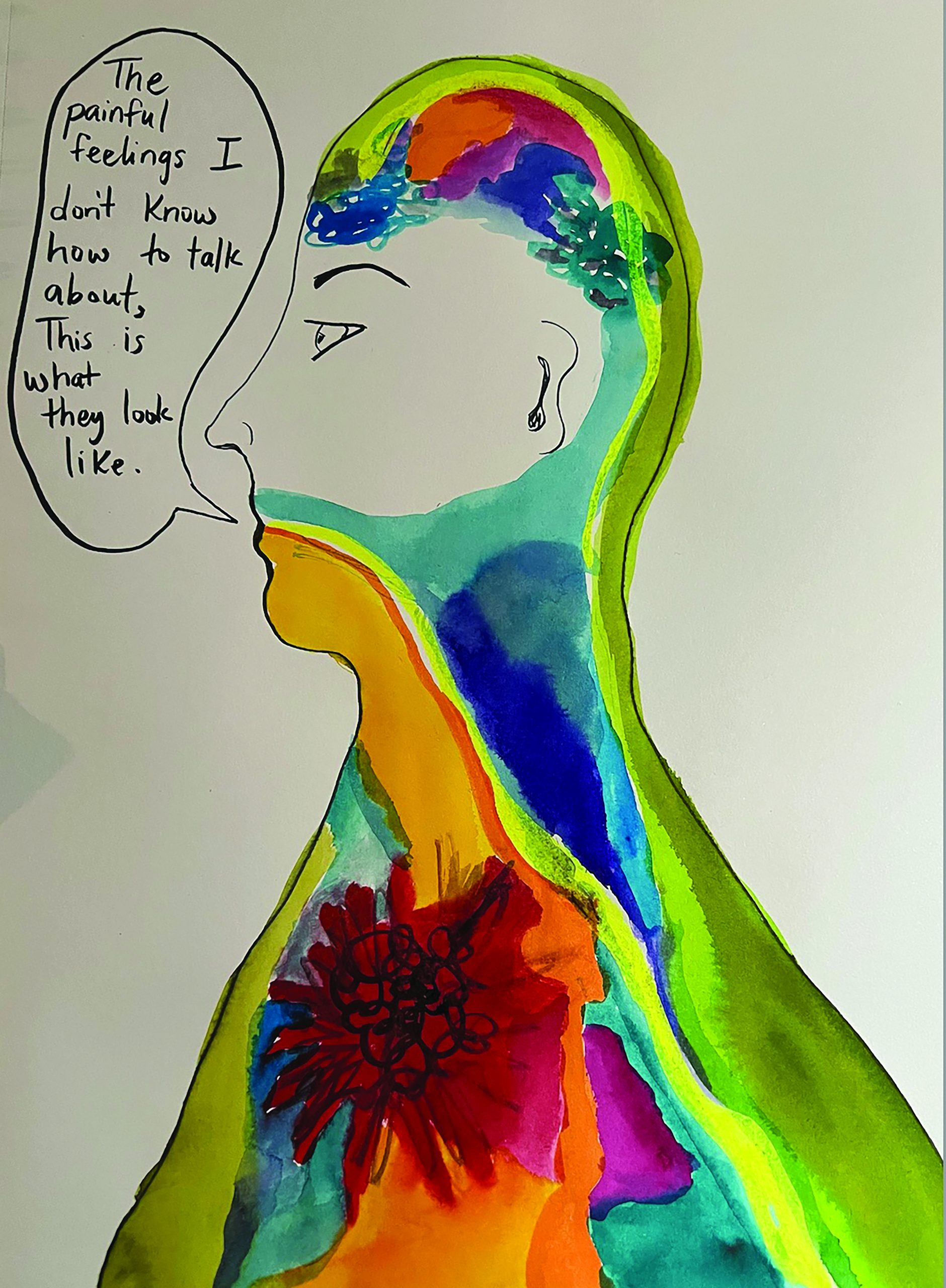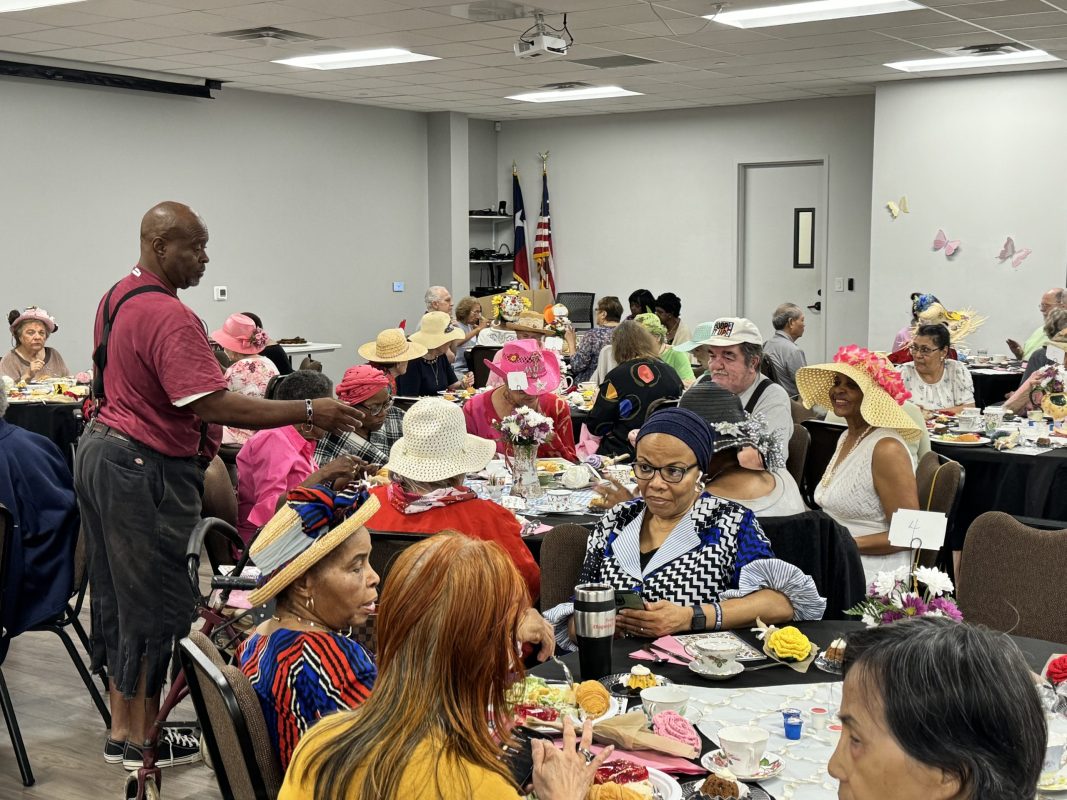A Place of Hope and Healing Through Creative Expression
Years ago, Dallas Art Therapy founder Andrea Davis attended an art therapy exhibit hosted by the now-closed Art Therapy Institute in Dallas. At that exhibit one piece, a handmade doll with a torn dress carefully mended in each spot, truly stood out to her. Attached to the doll was a letter from its creator, written to her younger self. In the note, the creator promised to care for her inner DAT volunteers at Back to School event for veterans’ families it. A recent interview with Davis shed light on this very special nonprofit organization. child, both then and now, despite past neglect. Witnessing that “mending” of a painful past through art was deeply moving to Davis. In that moment, Davis knew that, despite having just earned a Master’s degree in humanistic psychology, she had to become an art therapist. In 2017, Davis founded Dallas Art Therapy to make art therapy accessible to anyone in the community who needed.
 Artwork of eight-year-old boy mentioned in Davis’s responses
Artwork of eight-year-old boy mentioned in Davis’s responses
Otte: What is the core mission of Dallas Art Therapy, and how does it guide your work in the community?
Davis: We believe in creating a safe space for individuals to explore difficult emotions without feeling overwhelmed.
By externalizing experiences through art, people can gain new insights and work through layers of emotion at their own pace—an approach that often leads to more sustainable healing, self-discovery, and authentic living. We mentor art therapy master’s students and graduates who are trained to use art and psychology to help clients tap into their creative resources, address real-life challenges, and nurture emotional well-being. This vision drives all our efforts, from forming new partnerships to creating environments where art can be a transformative tool. We also strive to advance the art therapy profession. Currently, we’re supporting Senator Royce West’s SB 1081 and Representative Rafael Anchia’s HB 4557, which both advocate for art therapy licensure. By endorsing these bills, we aim to join the 14 other states that already have licensure, allowing more people to benefit from credentialed art therapy.
Otte: How would you describe the impact of art therapy on individuals’ mental and emotional well-being?
Davis: Art therapy offers a holistic way to promote mental and emotional health by merging sensory experiences, cognitive processing, and creative expression. For those who struggle with traditional talk therapy, art provides a nonverbal avenue for exploring complex feelings, developing coping skills, and processing life’s challenges. The creative process itself can be both empowering and revealing; participants often see tangible evidence of their growth through their artwork. Licensed art therapists play a key role, guiding clients in a safe, supportive environment. They help clients process the artwork, offer emotional support, and foster self reflection. Through this blend of creativity, professional insight, and self exploration, art therapy helps reduce anxiety, promotes self-awareness, and cultivates a sense of personal empowerment.
 Art about art therapy
Art about art therapy
Otte: What types of individuals or communities typically seek services from Dallas Art Therapy?
Davis: Our clients range from children and teens to adults and seniors, each facing different challenges—trauma, grief, chronic illness, or developmental and behavioral issues. Many come via referrals from schools, community groups like the VA, and other healthcare providers, while others f ind us through word-of-mouth or our website at dallasarttherapy.org.
Otte: Is there a particular success story or transformation you’ve seen in one of your clients that you can share with our readers?
Davis: One example involves an eight-year-old boy whose drawing skills and academic performance were both below expectations for his age. During art therapy sessions, we offered him a variety of art materials and art directives, which not only helped him explore his natural creativity but also gave him a nonverbal outlet to process difficult emotions, specifically surrounding family conflict, loss and addiction. Through his artwork, he found a way to externalize the grief of losing a parent, creating a visual narrative that captured the emotional complexity he couldn’t express in words. Over time, as he gave space for his grief to be seen in art therapy sessions, his drawing skills developed, and his academic performance improved right alongside them. This progress underscores how essential hands-on art-making can be—particularly in a world where children increasingly rely on screens and may miss out on the developmental advantages of drawing or handwriting. By harnessing the tactile and sensory aspects of creativity, art therapy not only helped him process his emotions but also bolstered his coordination, self-esteem, and overall success in the classroom.
Otte: How is Dallas Art Therapy funded?
Davis: We rely on a diverse funding model which combines individual, corporate and community donations; grants from government and private foundations aimed at mental health or arts-based programs; and program fees with a sliding-scale fee for out-of pocket clients. For those who prefer to use insurance, we share space with Davis Art Therapy & Counseling, an in-network provider for many insurance plans. We also host fundraising events. Initiatives such as the North Texas Giving Day, community projects, and our annual Anita Mester symposium help us raise awareness and support our work. Otte: What are your ties to Richardson? How do you engage with the community to raise awareness about art therapy and its benefits? Davis: Richardson holds a special place in our hearts—its diverse, arts rich community aligns with our passion for creative expression. We’re a proud member of the Richardson Chamber of Commerce and collaborate with school counselors in Richardson ISD, who refer students to us for art therapy services. We also host Workshops, like those with the University of Texas at Dallas (UTD) and Leadership Richardson, alongside our weekly Thursday SOS open studio. Our current collaboration with the UTD 180 Degrees student team is helping us fine-tune our website and processes for collecting outcome data for art therapy services. In addition, we partner with local mental health professionals and engage UTD psychology student volunteers, ensuring that the healing power of art therapy remains visible and available to the broader Richardson community.
For more information about Dallas Art Therapy, go to dallasarttherapy.org or on Instagram @dallasarttherapy.





Good https://is.gd/N1ikS2
Very good https://is.gd/N1ikS2
Keep this going please, great job!
I believe that is among the such a lot significant information for me.
And i am happy studying your article. But want
to remark on some general things, The web site style is great, the articles is
actually excellent : D. Just right job, cheers
Also visit my homepage: Click Here
Possessing a lorry is more than just delighting in the
freedom of the open road it’s a significant investment.
Like any type of investment, it needs care and interest to
keep it carrying out at its finest. Regular lorry
upkeep is commonly overlooked, but it plays a crucial function in guaranteeing safety and security,
performance, and longevity. By embracing a consistent upkeep routine, automobile owners can shield their investment, stay clear of unforeseen break downs, and save money in the
future.
Greetings! This is my first comment here so I just wanted to give a quick shout out and
tell you I genuinely enjoy reading through your blog posts.
Can you suggest any other blogs/websites/forums that cover
the same topics? Thanks a ton!
My web-site Visit Website
Simply desire to say your article is as astonishing.
The clearness for your put up is simply cool and i
could assume you’re a professional in this subject. Well together with your
permission let me to clutch your feed to keep up to date with
forthcoming post. Thank you a million and please keep
up the gratifying work.
It is appropriate time to make some plans for the future and it’s time to be happy.
I’ve read this post and if I could I desire to suggest you
few interesting things or suggestions. Maybe you can write next articles
referring to this article. I desire to read more things about it!
naturally like your web site however you have to take a look at the spelling on several
of your posts. A number of them are rife with spelling problems and I find it very troublesome to
inform the truth nevertheless I will surely come again again.